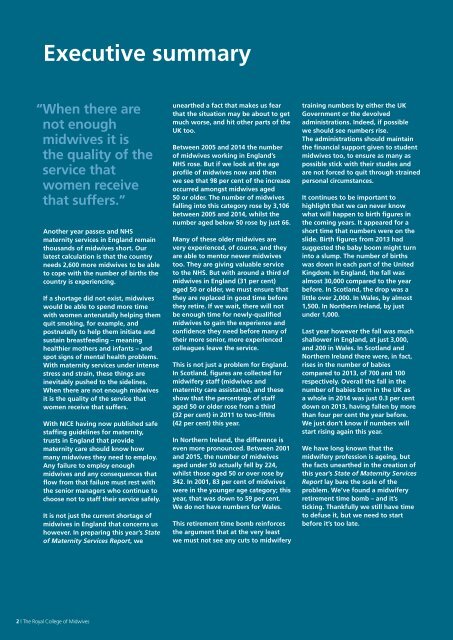Create successful ePaper yourself
Turn your PDF publications into a flip-book with our unique Google optimized e-Paper software.
Executive summary<br />
“When there are<br />
not enough<br />
midwives it is<br />
the quality <strong>of</strong> the<br />
service that<br />
women receive<br />
that suffers.”<br />
Another year passes and NHS<br />
maternity services in England remain<br />
thousands <strong>of</strong> midwives short. Our<br />
latest calculation is that the country<br />
needs 2,600 more midwives to be able<br />
to cope with the number <strong>of</strong> births the<br />
country is experiencing.<br />
If a shortage did not exist, midwives<br />
would be able to spend more time<br />
with women antenatally helping them<br />
quit smoking, for example, and<br />
postnatally to help them initiate and<br />
sustain breastfeeding – meaning<br />
healthier mothers and infants – and<br />
spot signs <strong>of</strong> mental health problems.<br />
With maternity services under intense<br />
stress and strain, these things are<br />
inevitably pushed to the sidelines.<br />
When there are not enough midwives<br />
it is the quality <strong>of</strong> the service that<br />
women receive that suffers.<br />
With NICE having now published safe<br />
staffing guidelines for maternity,<br />
trusts in England that provide<br />
maternity care should know how<br />
many midwives they need to employ.<br />
Any failure to employ enough<br />
midwives and any consequences that<br />
flow from that failure must rest with<br />
the senior managers who continue to<br />
choose not to staff their service safely.<br />
It is not just the current shortage <strong>of</strong><br />
midwives in England that concerns us<br />
however. In preparing this year’s <strong>State</strong><br />
<strong>of</strong> <strong>Maternity</strong> <strong>Services</strong> <strong>Report</strong>, we<br />
unearthed a fact that makes us fear<br />
that the situation may be about to get<br />
much worse, and hit other parts <strong>of</strong> the<br />
UK too.<br />
Between 2005 and 2014 the number<br />
<strong>of</strong> midwives working in England’s<br />
NHS rose. But if we look at the age<br />
pr<strong>of</strong>ile <strong>of</strong> midwives now and then<br />
we see that 98 per cent <strong>of</strong> the increase<br />
occurred amongst midwives aged<br />
50 or older. The number <strong>of</strong> midwives<br />
falling into this category rose by 3,106<br />
between 2005 and 2014, whilst the<br />
number aged below 50 rose by just 66.<br />
Many <strong>of</strong> these older midwives are<br />
very experienced, <strong>of</strong> course, and they<br />
are able to mentor newer midwives<br />
too. They are giving valuable service<br />
to the NHS. But with around a third <strong>of</strong><br />
midwives in England (31 per cent)<br />
aged 50 or older, we must ensure that<br />
they are replaced in good time before<br />
they retire. If we wait, there will not<br />
be enough time for newly-qualified<br />
midwives to gain the experience and<br />
confidence they need before many <strong>of</strong><br />
their more senior, more experienced<br />
colleagues leave the service.<br />
This is not just a problem for England.<br />
In Scotland, figures are collected for<br />
midwifery staff (midwives and<br />
maternity care assistants), and these<br />
show that the percentage <strong>of</strong> staff<br />
aged 50 or older rose from a third<br />
(32 per cent) in 2011 to two-fifths<br />
(42 per cent) this year.<br />
In Northern Ireland, the difference is<br />
even more pronounced. Between 2001<br />
and <strong>2015</strong>, the number <strong>of</strong> midwives<br />
aged under 50 actually fell by 224,<br />
whilst those aged 50 or over rose by<br />
342. In 2001, 83 per cent <strong>of</strong> midwives<br />
were in the younger age category; this<br />
year, that was down to 59 per cent.<br />
We do not have numbers for Wales.<br />
This retirement time bomb reinforces<br />
the argument that at the very least<br />
we must not see any cuts to midwifery<br />
training numbers by either the UK<br />
Government or the devolved<br />
administrations. Indeed, if possible<br />
we should see numbers rise.<br />
The administrations should maintain<br />
the financial support given to student<br />
midwives too, to ensure as many as<br />
possible stick with their studies and<br />
are not forced to quit through strained<br />
personal circumstances.<br />
It continues to be important to<br />
highlight that we can never know<br />
what will happen to birth figures in<br />
the coming years. It appeared for a<br />
short time that numbers were on the<br />
slide. Birth figures from 2013 had<br />
suggested the baby boom might turn<br />
into a slump. The number <strong>of</strong> births<br />
was down in each part <strong>of</strong> the United<br />
Kingdom. In England, the fall was<br />
almost 30,000 compared to the year<br />
before. In Scotland, the drop was a<br />
little over 2,000. In Wales, by almost<br />
1,500. In Northern Ireland, by just<br />
under 1,000.<br />
Last year however the fall was much<br />
shallower in England, at just 3,000,<br />
and 200 in Wales. In Scotland and<br />
Northern Ireland there were, in fact,<br />
rises in the number <strong>of</strong> babies<br />
compared to 2013, <strong>of</strong> 700 and 100<br />
respectively. Overall the fall in the<br />
number <strong>of</strong> babies born in the UK as<br />
a whole in 2014 was just 0.3 per cent<br />
down on 2013, having fallen by more<br />
than four per cent the year before.<br />
We just don’t know if numbers will<br />
start rising again this year.<br />
We have long known that the<br />
midwifery pr<strong>of</strong>ession is ageing, but<br />
the facts unearthed in the creation <strong>of</strong><br />
this year’s <strong>State</strong> <strong>of</strong> <strong>Maternity</strong> <strong>Services</strong><br />
<strong>Report</strong> lay bare the scale <strong>of</strong> the<br />
problem. We’ve found a midwifery<br />
retirement time bomb – and it’s<br />
ticking. Thankfully we still have time<br />
to defuse it, but we need to start<br />
before it’s too late.<br />
2 | The Royal College <strong>of</strong> Midwives


